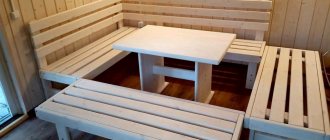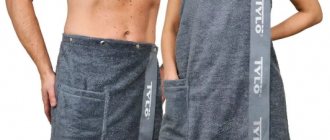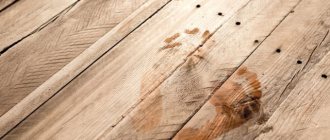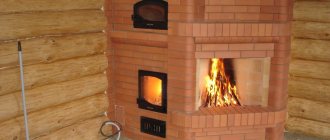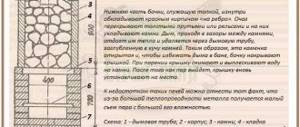Devices for a bath are a number of accessories, without which it is unrealistic to call the ritual of cleansing one hundred percent pleasant and necessary.
Elegant and comfortable items create a special atmosphere of comfort and complete fusion with the tradition of the manipulations performed. Brooms and brushes, hats and slippers, temperature indicators and hygrometers - this is only a small part of what falls under this definition.
The creation of bath accessories has entered a new stage of development; the products offered by companies can amaze even the seasoned client. But many, however, prefer devices carefully made with their own hands.
How to prepare a bath broom?
The bath broom is the ruler of accessories and the ruler of the Russian bath.
But to be one hundred percent sure of its environmental purity, you may need to do it yourself. At the same time, do it correctly, since otherwise it will be enough for exactly one time.
The most convenient and in most cases used broom is made from tree branches. You can choose almost any tree, but be careful, since thorns, dirt, and the risk of harmful substances escaping from the broom are, of course, not what you expect from a relaxing bath. The winners in popularity are birch and oak standards.
Really curious! If you want to get a tangible healing effect from a broom, you can prepare it from herbs, for example, from nettle. And from mint, lemon balm, wormwood.
The best branches for a broom are those that have young, small foliage (June). Oak blanks can be collected all summer - they do not quickly lose their own suitable parameters. The weather for “hunting” them should be dry and hot.
Choose narrow, straight and resilient branches. Their best length is from forty to sixty cm. It will be very problematic to tie branches that are too small.
Important! Don't be barbarians, cut suitable "material" from different trees!
Before you start knitting a broom, you need to clear the lower part of each branch from leaves and various twigs. When collecting the “elements” into a single structure, systematically shake the “bun” so that it turns out beautiful, even, dense and curly.
The technique of knitting brooms itself is, in principle, simple. The branches are fastened with synthetic strong twine. The first knitting should be placed closer to the end of the handle and tightened loosely. After which the broom is divided in half and intertwined with force: the left part is “led” through the top to the right, the right part through the bottom to the left. And without that a couple of times. The handle ultimately comes out tight, the rods do not stick out in different directions. Because the material for the broom is taken fresh, everything is twisted quite simply.
For the second tie, use the same twine, but take a piece of real twine and tie it as high and tight as possible. The ends of the “clamp” are not trimmed; they will later serve to connect the brooms into pairs. At the end of the knitting, the ends of the branches on the handle are carefully cut off with a sharp ax.
“Freshly prepared” brooms are hung in the attic to dry. Once the pages reach a brittle state, the brooms are wrapped in paper, leaving only the handle “free.” They are preserved in this form. Absolutely - in a closet or drawer, into which neither light nor dampness can reach.
Broom
Of course, a broom is the main attribute in a bathhouse. There is even a saying: A bath broom is older than the Tsar, if the Tsar takes a steam bath!
A broom is, by and large, a special medical instrument. Because it is capable of providing a powerful massage effect, improving blood circulation, increasing blood flow, and saturating the air with aromas. As a result, metabolism accelerates. And in the complex there is a healing and rejuvenating effect.
What are bath brooms made from?
Bath accessories: brooms made from deciduous tree branches
Brooms for the steam room are prepared from branches of deciduous trees: birch, linden, oak, rowan.
Birch broom
Traditional healers consider a broom made from flexible birch branches with elastic leaves to be the best. Because thanks to the aromas inhaled with steam and superficial massage, birch cleanses the skin pores. Broom leaves, when massaged, remove sweat and toxins from the skin. But it is known that the healing of the body begins with its cleansing.
The preparation of branches is usually done 10-15 days after the Trinity Day. At this time, the plant buds contain the maximum amount of flavonoids, resins, and essential oils. Young, recently blossoming leaves are rich in ascorbic and betulorethic acids, phytoncides and saponins. It is these substances that have a healing effect.
Oak broom
An oak broom is a classic bath attribute, especially recommended for oily skin. Because, thanks to the tannins, quercetin, and essential oils contained in the leaves, it helps cleanse the skin, restore its elasticity, and relieve inflammation. The esters released when the broom is steamed have a hypertensive effect.
Young elastic branches with young, medium-sized bright green leaves are prepared for the broom. It is better to take the lower branches, which receive the least amount of sunlight.
Brooms from other hardwoods
Linden brooms are prepared for the steam room. The aroma of linden has a calming effect, banishes insomnia and depression. The feeling of anxiety is relieved and the airways are cleared.
Eucalyptus brooms are less common, because the tree is southern. Eucalyptus leaves contain more than three percent essential oils, which, when inhaled, have a beneficial effect on the cardiovascular system and respiratory system. A properly prepared eucalyptus broom should have bright green leaves.
True experts add several stems of fragrant medicinal herbs to their bath brooms: wormwood, sage, chamomile, oregano, mint.
Coniferous brooms
Bath lovers highly value soft and fragrant fir brooms. Juniper trees are harsh and quite prickly, so only particularly persistent vapers use them.
You can find bamboo whisks in stores. Which can be used for light massage. But, to be honest, it is inferior to a traditional broom: there is no aroma.
Buckets, steamers, gangs
These wooden sauna devices can also be constructed without the help of others if you are thirsty.
To produce steamers and buckets, various types of wood are used - oak, aspen, linden. For gangs - pine, cedar. Their quantity can vary at your discretion (from 10 liters).
A set of perfectly fitted boards, a blank bottom, a metal hoop, twine, a couple of tools - and a high-quality container at your disposal. True, such amateur performances will require some abilities and serious perseverance.
In order for the devices acquired as a result of hard work to serve you for a long time, you must adhere to certain rules for their operation:
- Wood is a living material; it can dry out, become moldy, and burst. To prevent a similar problem from affecting your buckets, steamers and tubs, systematically scald them with boiling water at the end of the bath procedures. When finished, wipe dry and put away from the oven. Yes, yes, many devices for a Russian bathhouse require special care and high-quality care;
- If wood containers have not been used for a long time, they, one way or another, lose their density. Based on this, before bathing procedures, fill them to the top with cool water for a couple of hours. The material will swell and all microcracks will repair themselves. Then pour out the water and pour boiling water over the utensils to disinfect.
Worth knowing! When using oak brooms, do not be surprised that wood products that come into contact with them darken - tannins impart such a special color to any material.
Rules for using accessories
Of all the variety of offers on the market, wooden accessories for saunas and baths require a special approach during operation. In order to extend their “active life” you need to follow simple recommendations:
- Before purchasing, the product must be checked for leaks. In modern realities, tongue-and-groove riveting has become most widespread, that is, adjacent elements are locked together using a tongue-and-groove system, which greatly improves the quality of water retention. Products with visible defects should be rejected. Extensive fistulas are very difficult to eliminate even with prolonged soaking, about 12 - 14 days.
- Small leaks eliminate themselves after soaking, when the swollen wood, due to an increase in linear dimensions and volume, selects cracks.
- If the leak cannot be completely eliminated, you can try treating the outer surface with a hot mixture of 1 part beeswax and 2 parts linseed oil. The operation is convenient to perform using a flat brush made of natural bristles and a hair dryer. Particular attention should be paid to the processing of mornings. In some cases, it is necessary to upset the hoops using a hammer weighing 1000 - 1500 grams and a narrow copper or brass extension, shaped like a chisel with a blunt working part.
- Keep wooden accessories for baths and saunas filled with water up to the top rim.
- If this is not possible, then small-sized products should be moved to a cool, dark room and stored upside down. Opened leaks are eliminated by pre-soaking. You cannot leave empty containers in a steam room.
Scoop and ladle
The very first thing that the imagination draws is wooden devices. Wood for a bathhouse has a number of undoubted advantages, its low thermal conductivity is especially appreciated. But before you buy ladles for a bath (and suddenly you want to make them yourself), you should decide on the type of material from which they should be made. It is normal if it is oak, linden or aspen.
Important! To increase the service life of products, be sure to impregnate them with linseed oil or wax.
Another material widely used for the production of this type of bath utensils is metal. Products made from it have a very long service life - much longer than those made from wood.
But metal conducts heat amazingly - and this is where its hidden danger lies: there is a risk of getting burned. It is precisely on this basis that steel scoops and ladles should be equipped with wooden handles. It is better to choose (or make) devices from copper, stainless steel, brass - these materials do not corrode.
It is impossible not to mention plastic buckets and scoops. There are no contraindications to their use, unless you are really building a Russian bathhouse “for the soul” - such elements will simply stand out from a non-specialized interior.
Combined buckets can be called in demand - a plastic liner is inserted into a wooden base. Such standards are presentable on the outside and will last longer.
You should not buy into the uniqueness and style of glass products - breaking them is no more difficult than easy, in general, it is not convenient.
Important! To avoid cuts from fragments, the use of all glass accessories in the bathhouse is not recommended.
What are they made from?
Modern technologies make it possible to use a wide variety of materials for the production and manufacture of such bath interior items.
Plastics
Plastic is increasingly becoming part of the everyday life of modern people. This is partly good, but in the case of a bathhouse, not so much. Plastic and polymer masses under conditions of elevated ambient temperatures can be deformed, and in some cases, release volatile substances into the space, which can pose a certain threat to the health of those present. At the same time, such products are inexpensive, accessible, and can have a wide variety of colors, shapes and textures.
Although, frankly speaking, plastic frankly makes the perception of the classic decoration of a traditional bathhouse somewhat atypical and primitive. Therefore, it is better to leave it for decorating the entrance doors of office and industrial buildings. Somewhat indirectly in the line of plastics is the so-called plexiglass or acrylate. This is a transparent material that visually resembles glass, but is more resistant to destruction.
Glass
Glass signs look much more presentable compared to plastic ones. They are not as easy to scratch as acrylate ones, they do not acquire a yellowish tint when exposed to ultraviolet radiation, and do not deform when heated, but they are destroyed by direct mechanical impact. We admit that glass elements are perceived quite alienly in a Russian bathhouse with its overwhelming wooden interior. In the line of baths in the world, only the eastern bathhouse - the hammam - organically allows glass into its interior space, because even the hammam doors, in the vast majority of cases, are glass.
Natural and artificial stone
Such products look expensive, solid and are not affected by high temperature and humidity. The last circumstance is very important in the conditions of an oriental bath, where humidity often approaches 100%. Among the disadvantages of such products, it is worth noting, first of all, the high cost of raw materials and the complexity of processing, which implies the manufacture of such products almost exclusively in specialized and properly equipped enterprises.
Metal
Iron is prone to corrosion in high humidity conditions and requires either a protective chemical coating or painting. Metal signs for the bathhouse, which will be located outside, are good. They can be quite massive and decorated with forged elements, which will give them additional charm, color and ambiance. Inside, you can use elements made of stainless steel, bronze, copper, brass, titanium and aluminum.
Body brush
It is better to purchase some devices for the Russian bath, and many devices for the Turkish bath, especially which will become popular in the near future, rather than bother with creating them yourself. Since in the end it may not be exactly what you expected, and it will take a lot of time.
The brush is one of them specifically.
The main function performed by the brush is, of course, massage. Brushes for self-massage are equipped with long handles - with their help you can reach any part of the back.
These devices are made from wood, plastic, and silicone. The bristles themselves can vary in length and degree of hardness. It is advisable that it be made from natural materials, since, as experts say, artificial “lint” cleanses the skin much better.
If your bath procedures are a regular ritual, it is recommended to replace the brushes with new ones at least once every four months.
Wooden sauna sign
To make a sign for a bathhouse from wood, you first need to select a board.
The board must meet certain conditions so that something on the bath theme can be depicted on it in the future:
- the thickness of the board should be no more than 30mm. Agree that a 50mm board will be too bulky
- If the inscription will be made by carving, then it is best to find a board made of linden. This is soft wood, on which not only inscriptions, but also entire scenes on a bath theme can be easily obtained
- If the inscription is applied by burning, then any wood is suitable for this method...
What to do if you don’t know how to burn or cut? In the sense that you have never done this before, and you desperately and very urgently need a sign for a wooden bathhouse... Well, I really want to...
So, we will go the simplest and easiest way.
DIY washcloth
Washcloths are an indispensable bath attribute, so it’s not at all surprising that their range in stores does not stop growing. Soft and hard, big and small, round and square, in the shape of a loop and a mitten - your eyes will run wild. You should choose based on your own taste preferences, not forgetting the degree of skin sensitivity. Since the body may not perfectly perceive natural and synthetic standards.
If you were unable to find a good version of this device in the store, you may be able to make it yourself.
Knitting washcloths is, in principle, an easy process. Select sheep, goat or any other wool that suits your needs in terms of texture and stiffness, and start making your own crafts. First, the handle for the washcloth is knitted, and then the fabric itself is knitted until it reaches the appropriate length.
Pay attention! Try to make the handle very strong - otherwise it will lose its appearance after the first contact with water.
To free a washcloth of “initial” hardness, douse it with boiling water before the first use.
How to make a bath hanger?
Materials and tools:
- tree;
- plywood;
- wooden hooks, handles;
- drill;
- saw;
- sandpaper.
Arriving at any bathhouse, you need to undress, and the question arises: where to put things? That’s why a hanger will become indispensable in such a situation, since an ordinary wardrobe for things will look unaesthetic. The optimal solution is a wall hanger, and to make it yourself, you do not need any additional skills:
- First you need to make a template, which we will then transfer to the boards. If you plan to make several of these hangers, then it is best to make the template not from paper, but from plywood.
- Now we make markings for the hooks and drill holes. Additionally, make holes for mounting on the wall.
- Saw the blanks to assemble the base of the hanger.
- Make or buy wooden hooks.
- You need to sharpen the edges with sandpaper.
- Now you can start assembling the hanger and attaching it to the wall.
Bath towel - secrets from needlewomen
If you love and can sew, making your own bath towel can be no problem. To do this you will need terry cloth and very little time.
- Sew a wide elastic band on one side (behind the previously sewn around the perimeter);
- Cover this edge with decorative fabric;
- Sew Velcro to “fasten” the towel;
- If desired and necessary, add pockets and other decorative elements to the product - everything here is at the mercy of your imagination.
DIY scented soap
The finest soap for a bath with your own hands can be prepared using an opaque soap base.
Take 100 grams of base and melt in a regular water bath.
Stirring gently, add half a teaspoon of jojoba oil, a couple of drops of glycerin and two teaspoons of dried sea aquatic plants. At the very end of cooking, add 5 drops of eucalyptus or fir essential oil. If you are thirsty, you can add a greenish dye to the mixture at this time. Stir your brew well again and pour it into the molds. Don't worry, when the soap dries, it will easily separate from the containers.
If you often make “soap” devices for baths, photos of various master classes on the Internet will definitely intrigue you. So, you will be able to improve your skills and make beautiful bath gifts for friends and relatives.
Headrest
The headrest for a bath is a very ergonomic device. It helps to achieve complete relaxation when taking procedures in a lying position.
For its production, loose wood of all species is used. It is very comfortable to make such devices for a bathhouse with your own hands, since who, if not you, knows what dimensions and configuration are more desirable for your bathhouse.
Pay special attention to the quality of grinding of parts of the product, avoid sharp edges. Make sure that there are no nails or other steel elements protruding from the headrest, as this is a possible risk of local burns.
Additional accessories for procedures and relaxation
Equally important are the devices that allow you to create comfortable conditions for bathing procedures. These include rugs, ladders, headrests, washcloths and brushes.
Headrests
To get the healing effect of visiting the steam room, the main procedures are carried out in a lying position. This promotes rapid relaxation and uniform distribution of temperature over the entire surface of the body.
For these purposes, bath headrests of various shapes and sizes are used, made of wood with a low thermal conductivity coefficient - birch, linden and cedar. Fabric headrests filled with medicinal herbs are very popular.
Rugs and ladders
When visiting a steam room, it is important to observe the rules of personal hygiene and use special devices - rugs and ladders.
- The steam room rug is made of wood, felt or sheep wool. The product is used as a flooring for heated benches, shelves and bath floors. This device reliably protects the skin from burns and damage.
- The ladder is a wooden lattice made of linden and alder, which is installed on the floor in the steam room. It reliably protects your feet from overheating, slipping and burns. In addition, the gentle massage effect of the foundation on the feet leads to relaxation and recovery.
Brushes and sponges
Such devices are designed to keep the skin clean during bath procedures.
- The washcloth gently cleanses the top layer of skin from impurities and dead cells, improves blood flow, massages and tightens the skin. Natural and synthetic versions of washcloths are suitable for the bath; the former are expensive and safe, the latter are cheap, durable and practical.
- The brush is used to massage the back, thighs, arms and feet. Wood, plastic and silicone are suitable for making such accessories. When choosing a product, take into account the stiffness of the bristles and the length of the handle.
DIY bath hat
To prevent a visit to a bath or sauna from causing health problems, it is imperative to protect your head - with the help of bath caps. They prevent thermal shock due to the effect of the thermos.
Before you make devices for a bathhouse for such a responsible purpose, you should carefully study the types of fabrics suitable for these purposes. First, the fabric should be natural; however, neither silk nor linen are definitely suitable here. Fabrics for bath hats are made from natural wool, famous for its excellent heat-insulating qualities. Linen and cotton are used with no less furore. But the most popular materials are still felt and felt.
Really curious! Both felt and felt are made from felted wool, only felt is dense and rough, and felt is narrow and light. Felt is popularly called “generous felt.”
The felt hat is about a centimeter thick, but it's not creepy because the wool breathes. Felt is made by hand using felting from sheep wool. But don’t worry, to make a bath cap with your own hands you don’t necessarily have to bother with felting - you can easily buy it at any specialty store.
The first requirement for a bath cap is convenience. Based on this, just like with any other sewing, you need to start with a pattern.
To do this, you will need the following materials and tools:
- Pattern paper;
- Pencil;
- Awl/thick needle;
- Tailor's scissors;
- Centimeter;
- Ruler;
- Thick wool threads;
- Felt pieces.
To make a pattern, first determine the head circumference of the person for whom the hat is practically intended. Based on the taken value, calculate the size of the wedges that will make up the headdress.
The width of the wedge is a quarter of the head circumference plus one centimeter, the height is the same, only add a few, or two, or maybe more cm. Everything depends on the desired height of the future hat.
After which an isosceles triangle is constructed on paper, in which:
- The base is the width of the wedge;
- Height - the height of the wedge.
- Its corners are not rounded enough and the taken figure is cut out. The pattern is ready.
Important! To make the pattern last as long as possible, you can glue it to cardboard.
If the felt is thick, then the wedges made using simple manipulations are sewn end to end. The narrower one is sewn with a decorative seam on the front side. It is better to take visible threads so that the hat is more catchy and non-standard.
It is worth sewing a felt loop (or at least some kind of lace) into the top of the hat - the headdress will have to be hung out somehow to dry. Decorating the cap is completely and one hundred percent in your hands - you have the opportunity to trim the edge of the uniform with braid, make an applique on it from felt or any non-fading fabric, embroider a very general pattern or a sketch aimed at a specific theme.
Men's attire, at the request of the future wearer, can be embellished with a battle motto, while women's attire can be embroidered with beads, sequins, and beads. But in your zeal to make the hat unique and inimitable, try not to overdo it - this is not an element of a carnival costume.
Really curious! You can embroider the name or initials of the wearer on the cap - this way, when visiting the bathhouse with a huge group, things will not get mixed up.
How to make a wood panel?
A wooden panel for a bath is made as follows. Wood carving is mainly done to decorate tables and chairs. But another interesting element is considered a wooden panel, which can usually be found in recreation rooms. Before you decide to make such a panel, try to first decide on a pattern. True, you can find a ready-made drawing or develop it yourself.
The most popular is a panel or sign that depicts a bathhouse attendant with equipment. But another popular option is a sign with the inscription “To wash in the bathhouse - to be born again” or “The fragrant steam heals not only the body, but also the soul.”
Such a panel with a picture or a sign with an inscription can be bought in a store or from people involved in wood carving, but the option of making it yourself cannot be ruled out.
Materials and tools:
- beam;
- sharp knife;
- pens;
- galvanized fastenings;
- stain;
- turpentine;
- linseed oil.
In such cases, you can choose any tree. To manufacture such accessories, work is performed sequentially, namely:
- We take a block and begin to grind it from the inside.
- After the sanding process has been completed, you need to use a knife to cut out the design.
- After the drawing is ready, we cover its cut out elements with water stain.
- We treat the rest of the part with a solution of linseed oil and turpentine.
- The last step is nailing the galvanized fasteners.


